Early in his career, Carter came back from his guiding season absolutely on fire to continue his healthy eating habits. As I don’t have any healthy eating habits, I jumped right in there to assist, and learn from his good example. Lots of folks are choosing to eat vegetarian dishes more frequently in the interest of better health. This recipe is a good place to start.
Like just about everybody I know, Carter is a keen and willing cook – just not every night. His friend Kari (and mine too) is ahead of the game with her plan-ahead approach. The strategy is to do all the prep and make bases for meals that last in the fridge for at least 4 days, or will freeze in single servings for quick meals on those nights when even thinking about cooking is a chore. That’s why the supermarket deli counter is doing such a land-office business, I think – tired people just want to point, pay and eat. It gets a little expensive, though. Carter brought home a deli barley and lentil salad that he enjoys, and it was pretty easy to see how we could replicate it to suit his particular dietary restrictions, still keeping it open to variations to keep boredom at bay.
Here’s the recipe for a salad base that can be frozen in single servings, and a whole bunch of ideas about how to put your personal touch on it.
For all my friends who have gluten-free requirements so can’t eat barley, you can substitute brown rice, quinoa, even certified gf oat groats. All these take different cooking times and methods, so you would need to cook your choice and your lentils separately. It makes your prep a little longer, but it’s worth it in the end.
Barley and Lentil Salad Base
This recipe made 3 cups of cooked barley and lentils, which would be three to six servings, depending on your appetite and how much other stuff you intend to add. This is a very dense salad, so a one-cup serving of the base would be good for an athlete, and a half-cup of base would be more suitable for a mere mortal.
Ingredients:
- ½ cup pot barley (or pearl barley, but pot barley has more “chew” and more bran)
- ½ cup green lentils (or brown lentils – any kind that cooks in the same time as the barley, so not red lentils, which will turn into soup by the time the barley is done)
- 4 cups of water to cook them in
- Lemon juice (or a really nice vinegar – see options below)
- Olive oil, or any kind of oil you like except sesame (the flavor of sesame oil is very strong, and it’s quite laxative in large quantities, so think of it as the ‘vanilla’ of oils)
- Seasoning – salt and pepper at least, but otherwise the sky’s the limit


Method:
Put the barley and lentils in a saucepan and cover with the water. Bring to a boil, then reduce to a simmer, and cook until both are tender, 20 to 30 minutes depending on your altitude. Don’t salt the water – it affects the cooking time for the lentils. This is a “swimming” method, rather than a pilaf method, so the water will not be completely absorbed by the barley and lentils.


While things are simmering away, make a little dressing of two parts lemon juice to one part olive oil. Two tablespoons of lemon juice and one tablespoon of oil will lightly dress the lentils and barley. You get to decide if you want a wetter mix. Add a good pinch of salt and a nice grind of pepper.


You can customize each salad you make if you wait to add additional seasonings just before serving. If, on the other hand, you want the whole batch of base to take on a particular flavor profile, add seasonings while the lentils and barley are hot, so they can soak everything up while they cool. I like garlic and onion in everything, so I add those flavors to my base right from the get-go. You can add fresh garlic and very finely chopped shallot, or you can add a shake of my favorite onion/garlic/herb/no salt added seasoning blend.
Drain the barley and lentils well. To save on dirty dishes, pop them right back into the cooking pot.
Add your oil and lemon juice mixture, stirring to distribute it evenly. The hot barley and lentils will absorb it pretty quickly. Taste them, and season with additional lemon juice, salt and pepper if needed. Cool in the refrigerator, stirring occasionally to prevent clumping. Just put the whole pot right into the fridge.
When it’s cold, package the mixture in single servings and stash them in the fridge or freezer, to finish later. You can use containers or zipper closure freezer bags, depending on how much room you have in your freezer.




You can finish your salad with any kind of cooked or raw vegetables, dried or fresh fruit, nuts or seeds, additional seasoning or fresh herbs. The salad Carter brought home was plainly dressed, and had corn and carrots added, but there are absolutely no limits here. This one has dried cranberries, oranges, almonds, and just a splash of orange juice. If I wanted even more flavor, I would have added orange zest and a tiny squirt of grainy mustard.

How about Beets and Boursin? Add some dill, red onion, and a touch of balsamic vinegar. A sprinkle of green onion makes it look more exciting.
Need a quick cheat? You can use bottled oil-and-vinegar-type dressing in place of the oil and lemon juice – any flavor you like. You can add a drizzle of any other kind of dressing when you choose your additions.
This is NOT a cheat: you can replace the lemon juice with the vinegar of your choice (as long as it isn’t plain old distilled vinegar – that’s cleaning solvent). Red or white wine, balsamic, or that lovely raspberry-flavored one you got last Christmas – they’re all good.

How about some Mediterranean flavors? Black olives, grape tomatoes, zuccchini and green onions, with a little white balsamic to amp up the flavor.
You can choose your favorite flavor profile to season up a batch of salad base, to enjoy your favorite flavors any time you like. If you’re crazy for curry, flavor up the base with exotic spices, and then finish it with any leftover cooked veggies you have on hand, from cauliflower to sweet potatoes. More of a Mexican kind of vibe for you? Set up the basic batch with Tex-Mex spicing, and finish it as needed with salsa, avocado, corn, black beans, etc., etc., etc., and a good squeeze of lime. For your amusement, I have listed some very basic ingredients for a variety of flavor profiles below. Use them as a springboard for creativity! Make the time you spend in the kitchen more exciting, and it won’t seem like such a chore.

Flavor Profiles (simplified for busy cooks)
Here are some easy ways to achieve different flavor profiles, and the name/lable you can apply to each. It’s a little snooty, I know, but one you have mastered it, you can say, “Yes, this is my Morrocan salad…” and the next day you can say, “Today I chose my Japanese salad…” and so on until people start asking you which restaurants you would recommend, at which point you say, “Actually, I don’t eat out much, because I know how to cook.” Smug, but sensible. You can eat very well, and still maintain a healthy budget. Remember — there are no rules, so check out your fridge for ingredients and have some fun.
French – Lentil salad is already very French. To the hot barley and lentils, add Dijon mustard, Herbs de Provence (rosemary, thyme, savory, chervil, tarragon, basil, or just buy it pre-mixed), finely chopped carrots/onion/celery (the classic mire poix, and those onions could be shallots), and use red or white wine vinegar. Chervil and tarragon both taste a bit like licorice, so fresh fennel would be a great addition to the salad when you serve it, along with any fresh herbs (except cilantro) you have on hand. Put it on a lettuce leaf and don’t forget to wear your beret.
Italian – To the base, add dried basil, oregano, garlic, a pinch of red pepper flakes. Use olive oil certainly, lemon juice, and perhaps a touch of balsamic vinegar. When you serve it, finish the salad with fresh tomatoes and herbs, artichoke hearts, and Parmesan cheese.
Greek – Use all the Italian ingredients, with extra emphasis on the rosemary and oregano. Finish the salad with black olives, diced tomato and cucumber, a little red onion and a sprinkle of crumbled feta.
Mexican – To the base, add dry spices: chili powder, cumin, garlic, onion. Use lime juice instead of lemon juice. I love chipotles in adobo, so I would certainly add a bit of that. Finish the salad with salsa, avocado (or that left-over guacamaole), green or red onions, black beans and cilantro. Olé.
Middle European – Add apple cider vinegar instead of lemon juice to the hot barley and lentils, and be sure to include onion with your seasoning. Dill or caraway each add distinctive flavors, and paprika makes for vibrant color. Draw on the flavors of your grandmother’s cooking, if she came from somewhere in Europe (remember her borscht?). Finish your salad with left-over roasted root vegetables and a dollop of sour cream.
Indian (Curry) – All Indian dishes start with onions, garlic and ginger. Once you have added the lemon juice and oil, flavor the salad base with curry powder or garam masala, cumin, coriander, a little cayenne, powdered garlic, onion and ginger, turmeric, tamarind and fenugreek if you have them on hand – any or all to taste. Start with a pinch and play from there, tasting as you go – you can always add more, but you can’t take any back. Finish your salad with dried fruit and a little coconut, or mix in a spoonful of chutney, and top with cilantro leaves.
Japanese – If this is a already favorite flavor profile for you, you probably have some miso on hand to add to the basic mix, along with a little sesame oil, rice vinegar, mirin and soy sauce. To finish the salad, add any vegetables you like along with pickled ginger, sesame seeds, some nice dried seaweed and just a tiny bit of wasabi.
“Thai” – This is not authentic by any means, and so I add the quotation marks. Add a splash of fish sauce, powdered onion, garlic and ginger, some soy sauce, rice wine vinegar, sesame oil and lime juice, either to the whole base while the barley and lentils are hot, or to the finished base for a single salad. Taste as you go. A little lemon zest can stand in for lemongrass. Finish the salad with lots of green onions, cilantro, and some finely sliced hot peppers. Mint or Thai Basil add a distinctive touch, but usually require a special shopping trip.
“Morrocan” – Again, not authentic, but this less-aggressive more-complex flavor profile is a favorite among foodies. Use lemon juice in the basic mix, and add a little cinnamon, turmeric and ginger along with salt and pepper. Add a little heat in the form of harissa if you have it, and a tiny pinch of cayenne or dried chili flakes if you don’t. Finish your salad with raisins or dried apricots and almonds, or carrots, bell peppers and chickpeas.
Play with your food! You’ll appreciate it more.




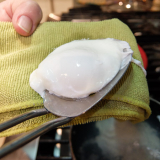
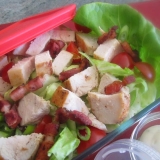


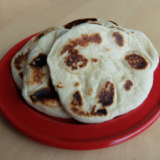

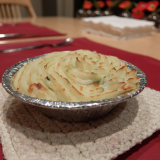
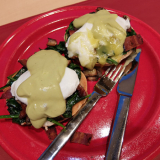

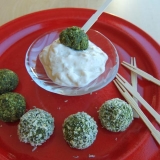

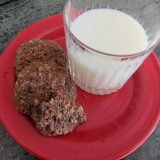
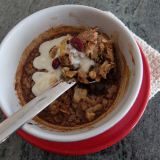
Leave A Comment